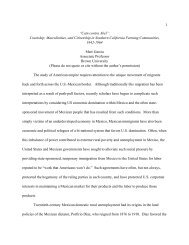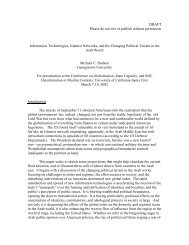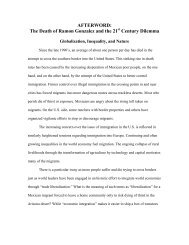An agro-ecological assessment of grower practices in California
An agro-ecological assessment of grower practices in California
An agro-ecological assessment of grower practices in California
You also want an ePaper? Increase the reach of your titles
YUMPU automatically turns print PDFs into web optimized ePapers that Google loves.
264 JULIE GUTHMANchickens are effectively used for both weed control andfield clean up, this sort <strong>of</strong> control is employed only onvery unusual diversified farms.It is worth mention<strong>in</strong>g here that frustration withthe lack <strong>of</strong> technologies for weed control is the mostcommonly stated impediment to expand<strong>in</strong>g organicproduction, although it is more accurately framed asa cost issue. After all, hand weed<strong>in</strong>g and hoe<strong>in</strong>g areeffective technologies, albeit extremely labor <strong>in</strong>tensiveones. In any case, many mixed <strong>grower</strong>s claim that therest <strong>of</strong> their operations are “virtually organic” exceptthat they use herbicides like Round-up R for spot orpre-emergent weed control.5. Bio-diversified cropp<strong>in</strong>g patternsWith the proliferation <strong>of</strong> <strong>in</strong>organic fertilizers s<strong>in</strong>ceWorld War II, the general trend <strong>in</strong> US farm<strong>in</strong>g hasbeen to m<strong>in</strong>imize rotations <strong>of</strong> fertility enhanc<strong>in</strong>g crops(Altieri, 1995). Although rooted <strong>in</strong> economic structures(e.g., land values, commodity subsidies), this sort<strong>of</strong> technological <strong>in</strong>novation has furthered tendenciestoward mono-cropp<strong>in</strong>g, which from an <strong>agro</strong>-<strong>ecological</strong>standpo<strong>in</strong>t, exacerbates all k<strong>in</strong>ds <strong>of</strong> non-fertility problems,such as disease, weed<strong>in</strong>ess, <strong>in</strong>sects pests, and s<strong>of</strong>orth. It has also enabled an unprecedented degree <strong>of</strong><strong>in</strong>tensification, as evidenced by <strong>grower</strong>s <strong>in</strong> the coastalareas who can get up to five cash crops per year on anyone piece <strong>of</strong> land, if the crop mix is right.Cover cropp<strong>in</strong>g and non-crop plant<strong>in</strong>gs havealready been discussed, both <strong>of</strong> which happen to<strong>in</strong>crease farm diversity, but are generally used morenarrowly as fertility management and pest controltechniques. The focus here is on farm diversity morebroadly as an <strong>in</strong>dication <strong>of</strong> <strong>in</strong>tensive management andecosystem-oriented cropp<strong>in</strong>g systems. 10 To <strong>in</strong>creasediversity with<strong>in</strong> agricultural systems, <strong>agro</strong>-ecologyrecommends that farmers plant and rotate crops <strong>in</strong>a mosaic pattern <strong>of</strong> small blocks, and <strong>in</strong>corporatenon-crop plants <strong>in</strong>to the <strong>agro</strong>-ecosystem.There is tremendous variation among organic<strong>grower</strong>s <strong>in</strong> regards to diversity, which is primarilyregional and crop specific, although there are clearconnections with scale and ideological predispositionsas well. In annual systems, the m<strong>in</strong>imum practice isthat <strong>of</strong> temporal crop rotations, where the same cropis never planted on the same piece <strong>of</strong> land twice <strong>in</strong> arow. The median is the practice <strong>of</strong> spatial and temporalrotations, that is, plant<strong>in</strong>g different crops, presumablywith very different strengths and susceptibilities,<strong>in</strong> small adjacent blocks, although block sizes canbe highly variable. This sort <strong>of</strong> practice is obviouslynot practical with gra<strong>in</strong> crops that are mechanicallyharvested. The maximum are poly-cultural <strong>practices</strong>,such as <strong>in</strong>ter-cropp<strong>in</strong>g vegetables between fruit trees,mix<strong>in</strong>g two or three crops <strong>in</strong> any given block, and<strong>in</strong>troduc<strong>in</strong>g livestock <strong>in</strong>to the cropp<strong>in</strong>g system. In perennialsystems, options are more limited, with them<strong>in</strong>imum be<strong>in</strong>g cover cropp<strong>in</strong>g, the median be<strong>in</strong>g varietaldiversity, and the maximum, aga<strong>in</strong> be<strong>in</strong>g some sort<strong>of</strong> poly-culture, such as <strong>in</strong>ter-cropp<strong>in</strong>g with annuals orlivestock <strong>in</strong>tegration.Almost all <strong>grower</strong>s do some crop rotations, eventhose <strong>in</strong> the largest scale mixed categories, and evenon their conventional acreage, although they may notnecessarily rotate <strong>in</strong> a fertility-enhanc<strong>in</strong>g crop. Thepattern observed <strong>in</strong> this study is that for produce crops,only strawberries, sweet potatoes, tomatoes, and carrotsare grown back-to-back <strong>in</strong> conventional systems,all <strong>of</strong> which are once a year crops. Although <strong>grower</strong>srecognize the potential for more difficult-to-conta<strong>in</strong>pest problems, especially nematodes, this pattern is<strong>of</strong>ten replicated when they move <strong>in</strong>to organic production.Small scale <strong>grower</strong>s <strong>of</strong> specialty crops such asheirloom tomatoes also face the same problem, but aremore <strong>in</strong>cl<strong>in</strong>ed to do <strong>in</strong>tensive soil improvement dur<strong>in</strong>gthe <strong>of</strong>f season.There is more significant variability <strong>in</strong> the degree <strong>of</strong>spatial diversity on any given parcel. At one extreme,some <strong>grower</strong>s will plant quarter-section blocks (160acres) <strong>in</strong> one organic crop, usually carrots or process<strong>in</strong>gtomatoes, which have well-developed markets.Other large scale, and mixed operators, plant <strong>in</strong> 20 to40 acre blocks, which viewed from the ground, hardlyseems diversified. What drives this sort <strong>of</strong> system isless a commitment to diversity, and more the fact thatthey may have only 80 to 160 acres <strong>in</strong> organic productionaltogether. Recogniz<strong>in</strong>g the need to do temporalrotations, these <strong>grower</strong>s have to spatially diversify tomeet their market<strong>in</strong>g obligations.When it exists, the sort <strong>of</strong> small block diversity<strong>of</strong> several species is found only on small to mid-sizefarms,andisasmuchguidedbymarket<strong>in</strong>gstrategyasanyth<strong>in</strong>g else. That is, those who do direct market<strong>in</strong>g,especially through subscription boxes and farmers’markets generally desire as diverse a crop mix as possibleto smooth out the tim<strong>in</strong>g <strong>of</strong> when crops becomeready and to have an array <strong>of</strong> choices for the buyer. Soeven direct market fruit <strong>grower</strong>s will diversify varietalsso they come ripe at different stages.Farms that <strong>in</strong>corporate near-ideal poly-cultures,however, are few and far between. I witnessed perennial/annual<strong>in</strong>ter-cropp<strong>in</strong>g on only four farms, three <strong>of</strong>which are owned by long time activists <strong>in</strong> susta<strong>in</strong>ableagriculture. All are subscription farms, where membercustomerssign-up <strong>in</strong> advance and receive a weeklybox <strong>of</strong> various commodities, and all have sales <strong>in</strong> themedium range. These farms and only a handful <strong>of</strong> othershave livestock on the farm, but the others tend tobe more segregated, where there may be a horse corral





